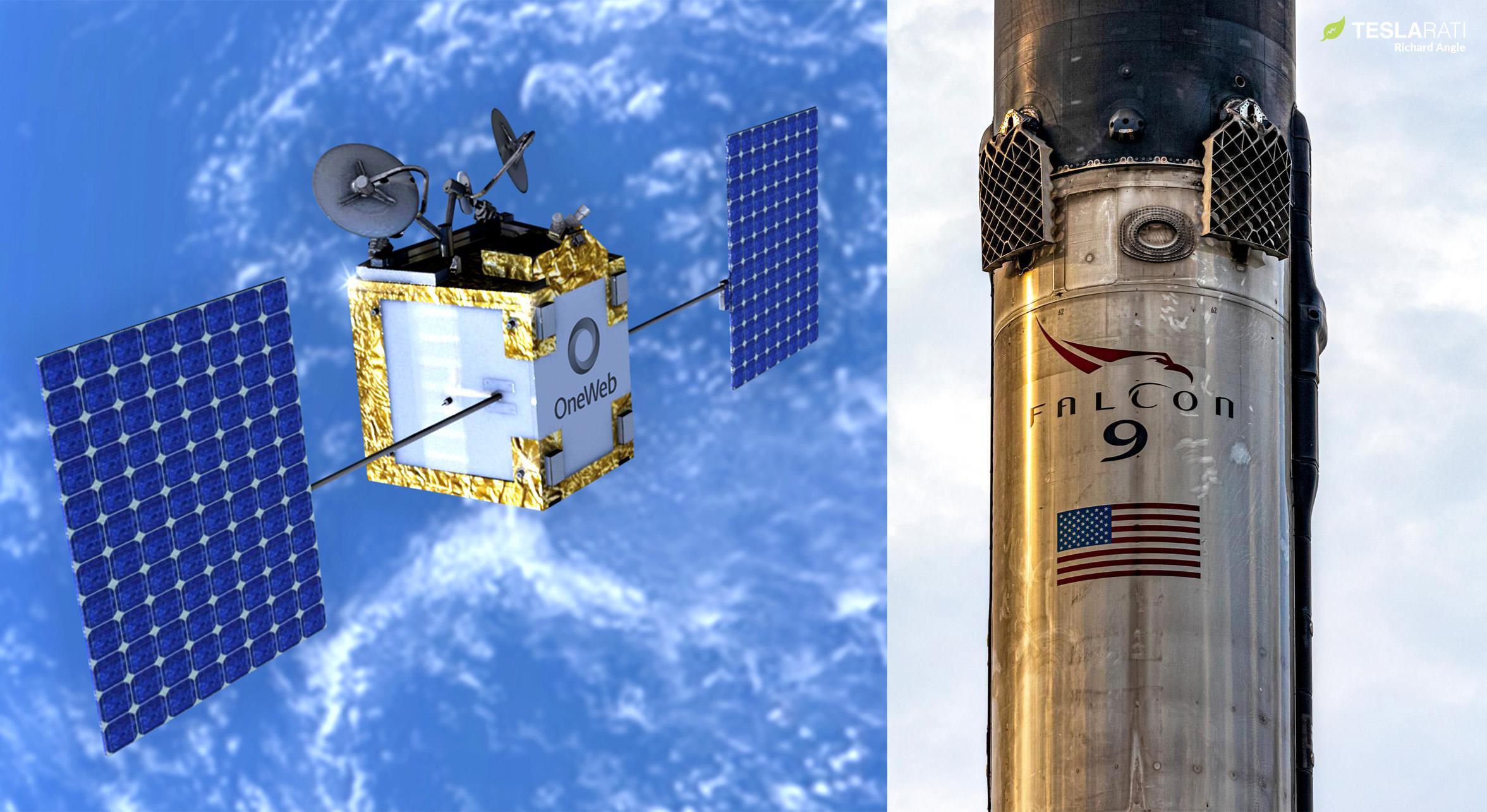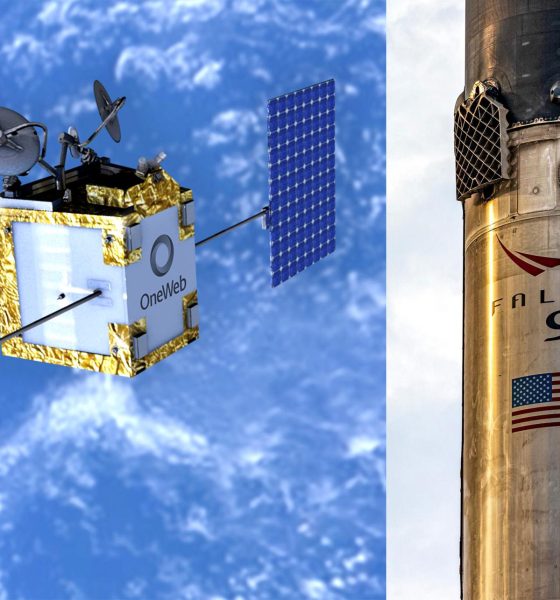

News
SpaceX wins OneWeb launch contracts, demonstrating extreme flexibility
Demonstrating a level of flexibility that no other commercial launch provider on Earth can likely match, SpaceX and OneWeb have entered into a major launch contract barely three weeks after Russia kicked the satellite internet company off of its Soyuz rockets.
Beginning in early 2020, OneWeb has launched approximately 430 operational small internet satellites – about two-thirds of its first constellation – on a dozen different Russian Soyuz 2.1b and ST-B rockets, including a mission completed as recently as February 10th, 2022. That nominal – albeit slow – deployment ground to a violent halt alongside Russia’s second unprovoked invasion of Ukraine on February 24th, 2022. Within a week, extraordinary Western economic sanctions pushed the unstable head of Russia’s Roscosmos space agency to retaliate by both ending the practice of European-owned Soyuz launches and holding OneWeb’s 13th operational launch hostage.
Another three weeks later, outside of increasingly tense and reluctant cooperation on the International Space Station, the relationship between Russian and Western spaceflight programs has effectively ceased to exist. That includes all 6-7 of OneWeb’s remaining Soyuz launch contracts, each of which the company had already paid more than $50 million for. Though OneWeb technicians were able to escape the increasingly hostile country, Russia effectively repossessed (i.e. stole) OneWeb’s remaining rockets and its 13th batch of operational satellites.
That left OneWeb in an unsurprisingly precarious situation. Having already gone bankrupt once, a major delay could be financially catastrophic for the company. Normally, procuring half a dozen near-term launch contracts at the last second would be virtually impossible. Indeed, ignoring a certain US company, no other launch provider on Earth could even theoretically find or build enough capacity to launch the last third of OneWeb’s constellation without at least a one or two-year delay. Luckily for OneWeb, SpaceX does exist.
As discussed in a March 2nd Teslarati newsletter, SpaceX is extraordinarily unique in a sea of expendable, outdated rockets.
“SpaceX – a direct competitor that is far more vertically integrated than OneWeb and has suffered no major issues from Russian sanctions – may be OneWeb’s only near-term option for its orphaned satellites. The only obvious alternative would be to self-inflict what could be years of delays to avoid SpaceX purely out of spite and instead wait for space to open up on the manifests of companies like Arianespace and ULA or for even less available rockets from India or Japan.
SpaceX has plans for as many as 52+ Falcon launches in 2022, many of which are Starlink missions that the company might be willing to partially replace with a handful of lucrative launches for OneWeb.”
Teslarati – March 2nd, 2022
Because of SpaceX’s exceptional vertical integration and decision to launch its own Starlink internet satellites, which directly compete with OneWeb, the company has dozens of flexible launches planned over the next year or two that it can feasibly convert into commercial missions. No other international launch provider on Earth has the ability to scavenge its own internal manifest to effectively create capacity for last-second commercial demand out of thin air.
At the cost of a handful of Starlink launches, of which SpaceX already has close to 2100 working satellites in orbit, the company will be able to almost heroically step in and complete OneWeb’s constellation, allowing the company to avoid a potential multi-year delay if forced to use other providers.
In fact, due to Europe’s chronic lack of domestic launch capacity as a result of years of Ariane 6 delays, even some institutional European satellites orphaned by Russia’s actions may ultimately be moved to SpaceX Falcon 9 rockets to avoid lengthy launch delays. All told, OneWeb has offered no specific details about the cost, the number of total missions procured, or any other changes implemented in its new SpaceX contract, but the company says it could begin launches as early as this summer – a truly extraordinary demonstration of flexibility from both OneWeb and SpaceX.

Elon Musk
Elon Musk’s X will start using a Tesla-like software update strategy
The initiative seems designed to accelerate updates to the social media platform, while maintaining maximum transparency.

Elon Musk’s social media platform X will adopt a Tesla-esque approach to software updates for its algorithm.
The initiative seems designed to accelerate updates to the social media platform, while maintaining maximum transparency.
X’s updates to its updates
As per Musk in a post on X, the social media company will be making a new algorithm to determine what organic and advertising posts are recommended to users. These updates would then be repeated every four weeks.
“We will make the new 𝕏 algorithm, including all code used to determine what organic and advertising posts are recommended to users, open source in 7 days. This will be repeated every 4 weeks, with comprehensive developer notes, to help you understand what changed,” Musk wrote in his post.
The initiative somewhat mirrors Tesla’s over-the-air update model, where vehicle software is regularly refined and pushed to users with detailed release notes. This should allow users to better understand the details of X’s every update and foster a healthy feedback loop for the social media platform.
xAI and X
X, formerly Twitter, has been acquired by Elon Musk’s artificial intelligence startup, xAI last year. Since then, xAI has seen a rapid rise in valuation. Following the company’s the company’s upsized $20 billion Series E funding round, estimates now suggest that xAI is worth tens about $230 to $235 billion. That’s several times larger than Tesla when Elon Musk received his controversial 2018 CEO Performance Award.
As per xAI, the Series E funding round attracted a diverse group of investors, including Valor Equity Partners, Stepstone Group, Fidelity Management & Research Company, Qatar Investment Authority, MGX, and Baron Capital Group, among others. Strategic partners NVIDIA and Cisco Investments also continued support for building the world’s largest GPU clusters.
News
Tesla FSD Supervised wins MotorTrend’s Best Driver Assistance Award
The decision marks a notable reversal for the publication from prior years, with judges citing major real-world improvements that pushed Tesla’s latest FSD software ahead of every competing ADAS system.

Tesla’s Full Self-Driving (Supervised) system has been named the best driver-assistance technology on the market, earning top honors at the 2026 MotorTrend Best Tech Awards.
The decision marks a notable reversal for the publication from prior years, with judges citing major real-world improvements that pushed Tesla’s latest FSD software ahead of every competing ADAS system. And it wasn’t even close.
MotorTrend reverses course
MotorTrend awarded Tesla FSD (Supervised) its 2026 Best Tech Driver Assistance title after extensive testing of the latest v14 software. The publication acknowledged that it had previously criticized earlier versions of FSD for erratic behavior and near-miss incidents, ultimately favoring rivals such as GM’s Super Cruise in earlier evaluations.
According to MotorTrend, the newest iteration of FSD resolved many of those shortcomings. Testers said v14 showed far smoother behavior in complex urban scenarios, including unprotected left turns, traffic circles, emergency vehicles, and dense city streets. While the system still requires constant driver supervision, judges concluded that no other advanced driver-assistance system currently matches its breadth of capability.
Unlike rival systems that rely on combinations of cameras, radar, lidar, and mapped highways, Tesla’s FSD operates using a camera-only approach and is capable of driving on city streets, rural roads, and freeways. MotorTrend stated that pure utility, the ability to handle nearly all road types, ultimately separated FSD from competitors like Ford BlueCruise, GM Super Cruise, and BMW’s Highway Assistant.
High cost and high capability
MotorTrend also addressed FSD’s pricing, which remains significantly higher than rival systems. Tesla currently charges $8,000 for a one-time purchase or $99 per month for a subscription, compared with far lower upfront and subscription costs from other automakers. The publication noted that the premium is justified given FSD’s unmatched scope and continuous software evolution.
Safety remained a central focus of the evaluation. While testers reported collision-free operation over thousands of miles, they noted ongoing concerns around FSD’s configurable driving modes, including options that allow aggressive driving and speeds beyond posted limits. MotorTrend emphasized that, like all Level 2 systems, FSD still depends on a fully attentive human driver at all times.
Despite those caveats, the publication concluded that Tesla’s rapid software progress fundamentally reshaped the competitive landscape. For drivers seeking the most capable hands-on driver-assistance system available today, MotorTrend concluded Tesla FSD (Supervised) now stands alone at the top.
News
Elon Musk’s Grokipedia surges to 5.6M articles, almost 79% of English Wikipedia
The explosive growth marks a major milestone for the AI-powered online encyclopedia, which was launched by Elon Musk’s xAI just months ago.

Elon Musk’s Grokipedia has grown to an impressive 5,615,201 articles as of today, closing in on 79% of the English Wikipedia’s current total of 7,119,376 articles.
The explosive growth marks a major milestone for the AI-powered online encyclopedia, which was launched by Elon Musk’s xAI just months ago. Needless to say, it would only be a matter of time before Grokipedia exceeds English Wikipedia in sheer volume.
Grokipedia’s rapid growth
xAI’s vision for Grokipedia emphasizes neutrality, while Grok’s reasoning capabilities allow for fast drafting and fact-checking. When Elon Musk announced the initiative in late September 2025, he noted that Grokipedia would be an improvement to Wikipedia because it would be designed to avoid bias.
At the time, Musk noted that Grokipedia “is a necessary step towards the xAI goal of understanding the Universe.”
Grokipedia was launched in late October, and while xAI was careful to list it only as Version 0.1 at the time, the online encyclopedia immediately earned praise. Wikipedia co-founder Larry Sanger highlighted the project’s innovative approach, noting how it leverages AI to fill knowledge gaps and enable rapid updates. Netizens also observed how Grokipedia tends to present articles in a more objective manner compared to Wikipedia, which is edited by humans.
Elon Musk’s ambitious plans
With 5,615,201 total articles, Grokipedia has now grown to almost 79% of English Wikipedia’s article base. This is incredibly quick, though Grokipedia remains text-only for now. xAI, for its part, has now updated the online encyclopedia’s iteration to v0.2.
Elon Musk has shared bold ideas for Grokipedia, including sending a record of the entire knowledge base to space as part of xAI’s mission to preserve and expand human understanding. At some point, Musk stated that Grokipedia will be renamed to Encyclopedia Galactica, and it will be sent to the cosmos.
“When Grokipedia is good enough (long way to go), we will change the name to Encyclopedia Galactica. It will be an open source distillation of all knowledge, including audio, images and video. Join xAI to help build the sci-fi version of the Library of Alexandria!” Musk wrote, adding in a later post that “Copies will be etched in stone and sent to the Moon, Mars and beyond. This time, it will not be lost.”








